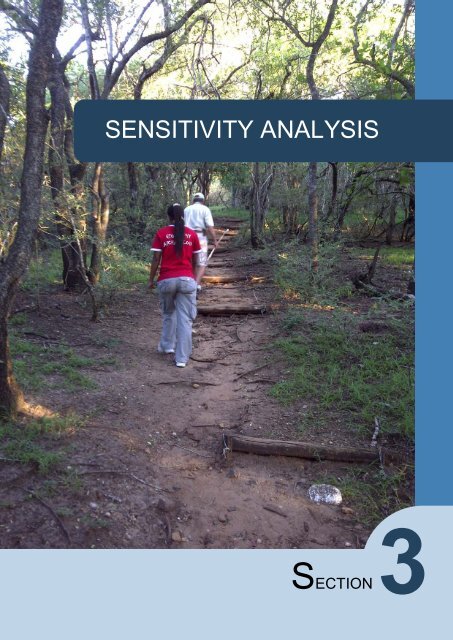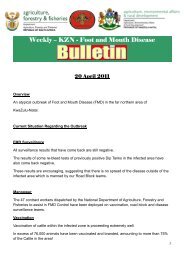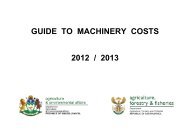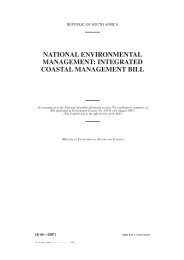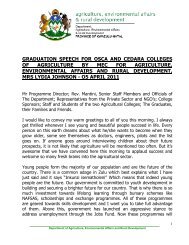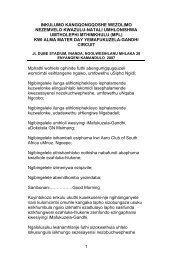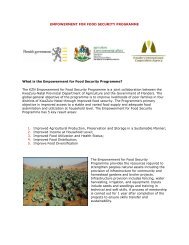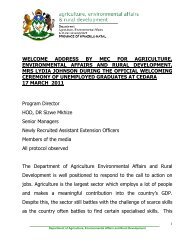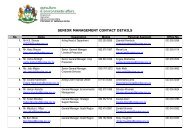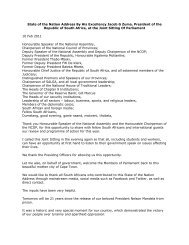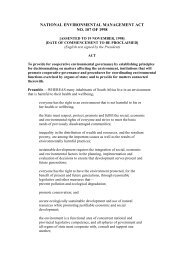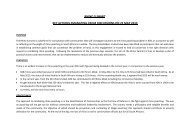SENSITIVITY ANALYSIS - Department of Agriculture and ...
SENSITIVITY ANALYSIS - Department of Agriculture and ...
SENSITIVITY ANALYSIS - Department of Agriculture and ...
You also want an ePaper? Increase the reach of your titles
YUMPU automatically turns print PDFs into web optimized ePapers that Google loves.
UKDM ENVIRONMENTAL MANAGEMENT FRAMEWORK<br />
<strong>SENSITIVITY</strong> <strong>ANALYSIS</strong><br />
SECTION 3<br />
Draft Desired State Report (May 2013) Page 28
UKDM ENVIRONMENTAL MANAGEMENT FRAMEWORK<br />
3 <strong>SENSITIVITY</strong> <strong>ANALYSIS</strong><br />
‘Sensitivity’ is regarded as the inherent quality <strong>of</strong> an environmental feature, which is<br />
derived from the following traits:<br />
Goods <strong>and</strong> services <strong>of</strong>fered;<br />
Scientific importance;<br />
Legal status / protection level; <strong>and</strong><br />
Vulnerability / tolerance to change.<br />
The process adopted in undertaking the sensitivity analysis for the EMF Desired State<br />
phase consisted <strong>of</strong> the following:<br />
1. Integrate spatially represented baseline information from the<br />
status quo assessment;<br />
2. Identify the environmental features <strong>and</strong> their<br />
associated attributes that portray the<br />
environmental sensitivity <strong>of</strong> UKDM, based on the<br />
outcomes <strong>of</strong> the Status Quo phase;<br />
3. Assign sensitivity ratings;<br />
4. Mapping <strong>of</strong> sensitivity by –<br />
a. Overlaying base layers in the Geographic<br />
Information System (GIS) to compile sensitivity<br />
maps for various environmental features; <strong>and</strong><br />
b. Combining separate sensitivity maps to prepare a<br />
composite map that reflects the Environmental<br />
Control Zones.<br />
3.1 Determining Sensitivity per Environmental Feature<br />
Groupings <strong>of</strong> homogenous environmental features <strong>and</strong> attributes in uMkhanyakude that<br />
depict the sensitivity <strong>of</strong> the area were allocated weightings, based on their intrinsic<br />
qualities that render them as sensitive. In this way, baseline information was transformed<br />
into secondary information that attached values to different features.<br />
Draft Desired State Report (May 2013) Page 29
UKDM ENVIRONMENTAL MANAGEMENT FRAMEWORK<br />
These ratings were based on input received from the environmental specialists that aided<br />
in compiling the EMF Status Quo Report. The sensitivity scale that was employed ranged<br />
from low to very high (see Table 2).<br />
Table 2: Environmental Sensitivity Scale (Note: sensitivity based on a single criterion /<br />
combination <strong>of</strong> criteria, where applicable to the feature)<br />
Sensitivity Rating<br />
Low<br />
<br />
Medium<br />
<br />
High<br />
<br />
Very High<br />
Description<br />
The inherent feature status <strong>and</strong> sensitivity is already significantly<br />
degraded. Environmental goods <strong>and</strong> services depleted /<br />
compromised. Any significant environmental – development<br />
change will not influence the current status.<br />
The inherent feature status <strong>and</strong> sensitivity will not be influenced<br />
by any significant environmental – development change.<br />
Environmental – development change may influence the current<br />
status <strong>of</strong> the feature, either negatively or positively. Feature<br />
<strong>of</strong>fers intact environmental goods <strong>and</strong> services / supports<br />
environmental goods <strong>and</strong> services <strong>of</strong>fered by other feature(s).<br />
Feature may be afforded legal protection status.<br />
Environmental – development change will significantly influence<br />
the feature, either negatively or positively. Feature <strong>of</strong>fers critical<br />
environmental goods <strong>and</strong> services. Feature afforded legal<br />
protection status.<br />
The sensitivity <strong>of</strong> the key environmental features in UKDM is portrayed in the subsections<br />
to follow.<br />
3.1.1 <strong>Agriculture</strong><br />
High value agricultural l<strong>and</strong> in UKDM must be conserved for production purposes, whilst<br />
concurrently addressing the need for economic growth <strong>and</strong> development in the district.<br />
High agricultural potential is regarded as a scarce non-renewable resource <strong>and</strong><br />
accordingly a risk averse <strong>and</strong> cautious approach should be adopted when development<br />
<strong>of</strong> such l<strong>and</strong> for purposes other than agricultural production is proposed.<br />
The overarching management mechanism (apart from legal provisions) is the KZN<br />
Agricultural L<strong>and</strong> Categories Spatial Decision Support tool which aims to guide <strong>and</strong> assist<br />
municipalities within the province with the compilation <strong>of</strong> various planning documents<br />
Draft Desired State Report (May 2013) Page 30
UKDM ENVIRONMENTAL MANAGEMENT FRAMEWORK<br />
such as the Integrated Development Plan's (IDP's), Spatial Development Framework's<br />
(SDF's) <strong>and</strong> L<strong>and</strong> Use Management Schemes (LUMS), but also to give direction to<br />
prospective developers when proposing l<strong>and</strong> use change.<br />
The table to follow reflects the sensitivity ratings assigned to the various agricultural<br />
attributes in the district.<br />
Table 3:<br />
Sensitivity Ratings assigned to Category: <strong>Agriculture</strong><br />
Category Sensitivity Criteria Attributes Rating<br />
Category A: Irreplaceable<br />
VH<br />
Category B: Threatened<br />
H<br />
Category C (Primary Agricultural L<strong>and</strong> Use)<br />
M<br />
AGRICULTURE<br />
KZN Agricultural<br />
L<strong>and</strong> Categories<br />
Category D: Secondary Agricultural L<strong>and</strong> Use<br />
Category E: Mixed L<strong>and</strong> Use<br />
M<br />
L<br />
Category Waterbodies<br />
Restricted<br />
Category Permanently Transformed<br />
Restricted<br />
Category Proclaimed Reserves<br />
Restricted<br />
Figure 10: Agricultural Sensitivity Map<br />
Draft Desired State Report (May 2013) Page 31
UKDM ENVIRONMENTAL MANAGEMENT FRAMEWORK<br />
3.1.2 Terrestrial Biodiversity<br />
The vision for terrestrial biodiversity in UKDM includes the following:<br />
Contributing to national conservation targets;<br />
Identifying sensitive areas <strong>and</strong> establish protection status;<br />
Protecting Critical Biodiversity Areas (CBA);<br />
Maintaining <strong>and</strong> promoting environmental corridors <strong>and</strong> connectivity;<br />
Maintaining the status <strong>of</strong> protected areas s<strong>and</strong> RAMSAR sites;<br />
Preventing the illegal or unsustainable use <strong>of</strong> natural resources;<br />
Restricting development in conservation priority areas;<br />
Protecting sensitive <strong>and</strong> conservation-worthy ecosystems (e.g. Sensitive S<strong>and</strong> Forest,<br />
Coastal Grassl<strong>and</strong>s);<br />
Eradicating alien invasive species (terrestrial <strong>and</strong> aquatic); <strong>and</strong><br />
Protecting Important Birding Areas.<br />
Apart from the strong legislative framework that protects terrestrial biodiversity, various<br />
mechanisms exist to manage the associated features. Protected areas are managed in<br />
accordance with their respective Integrated Management Plans (IMPs) <strong>and</strong> buffer zones<br />
(where applicable). In KZN the CBA is one <strong>of</strong> the sensitive layers against which several<br />
activities are listed, <strong>and</strong> which would require environmental authorisation in terms <strong>of</strong> GN<br />
No. R546 (2010) if the project falls within the CBA identified areas. The CBA map for<br />
UKDM has been created as part a strategic planning strategy to ensure biodiversity<br />
conservation <strong>and</strong> persistence in the district. A Biodiversity Sector Plan is also being<br />
developed for uMkhanyakude. The various authorities that are responsible for biodiversity<br />
management in the district include DEA, Ezemvelo KZN Wildlife (EKZNW) <strong>and</strong> the<br />
iSimangaliso Wetl<strong>and</strong> Park Authority.<br />
The rich biodiversity in UKDM is revealed in terms <strong>of</strong> the various sensitive features that<br />
are rated in the table to follow.<br />
Draft Desired State Report (May 2013) Page 32
UKDM ENVIRONMENTAL MANAGEMENT FRAMEWORK<br />
Table 4:<br />
Sensitivity Ratings assigned to Category: Terrestrial Biodiversity<br />
Category Sensitivity Criteria Attributes Rating<br />
TERRESTRIAL<br />
BIODIVERSITY<br />
Protected Areas<br />
Important Bird Areas<br />
Critical Biodiversity Areas<br />
Categories<br />
Community Conservation<br />
Area<br />
Stewardship Programme<br />
Transfrontier<br />
Conservation Areas<br />
(TFCAs)<br />
Vegetation types<br />
World Heritage Site - iSimangaliso<br />
Wetl<strong>and</strong> Park<br />
Nature Reserves - Statutory<br />
Protected<br />
Game Farms / Private Conservation<br />
areas<br />
CBA 1<br />
CBA 2<br />
CBA 3<br />
Usuthu-Tembe-Futi TFCA<br />
Ponta do Ouro-Kosi Bay TFCA<br />
Nsubane-Pongola TFCA<br />
Critically Endangered<br />
Endangered<br />
Vulnerable<br />
Least Threatened<br />
iSimangaliso Wetl<strong>and</strong> Park<br />
VH<br />
RAMSAR Sites<br />
Ndumo Game Reserve<br />
VH<br />
Core areas, which are needed to<br />
meet species <strong>and</strong> l<strong>and</strong>cover type VH<br />
targets<br />
Linkages, which are needed to meet<br />
Maputal<strong>and</strong> Centre <strong>of</strong><br />
connectivity targets <strong>and</strong> ensure<br />
Endemism Conservation<br />
each core area is not isolated.<br />
Planning<br />
These linkages can be managed<br />
H<br />
less intensively for conservation <strong>and</strong><br />
allow for climate change, plant <strong>and</strong><br />
animal dispersal, etc.<br />
Connectivity Ecological Corridors H<br />
Ridges with slopes > 5° Lebombo Mountain Range VH<br />
Ground-truthed sensitive<br />
H<br />
sites<br />
Transformation (KZN<br />
2008 Transformation<br />
Layer)<br />
Restricted<br />
VH<br />
VH<br />
M<br />
H<br />
VH<br />
H<br />
M<br />
H<br />
H<br />
H<br />
H<br />
H<br />
VH<br />
H<br />
H<br />
L<br />
Draft Desired State Report (May 2013) Page 33
UKDM ENVIRONMENTAL MANAGEMENT FRAMEWORK<br />
Figure 11: Terrestrial Biodiversity Sensitivity Map<br />
3.1.3 Terrain & Geotechnical Conditions<br />
The Development Potential Zonation (DPZ) (Table 5) conducted for UKDM as part <strong>of</strong> the<br />
Status Quo assessment is based on a geotechnical <strong>and</strong> engineering geological<br />
interpretation <strong>of</strong> bedrock geology, soil l<strong>and</strong> types, drainage <strong>and</strong> slope gradients. The<br />
assessment was based on the 1:250,000 published geological maps, the ARC-ISCW<br />
L<strong>and</strong> Type mapping <strong>and</strong> inventory data (Soil <strong>and</strong> Irrigation Research Institute, 1986 a, b,<br />
1988) <strong>and</strong> 90m SRTM Digital Elevation Model (DEM).<br />
The DPZ map provides a broad based geotechnical assessment <strong>of</strong> the study area which<br />
can be used in a regional development planning or conservation context. The map is the<br />
product <strong>of</strong> a desktop study <strong>and</strong> a site investigation was not carried out so this map must<br />
not be used to replace or substitute detailed geotechnical assessment <strong>of</strong> specific<br />
development sites.<br />
Draft Desired State Report (May 2013) Page 34
UKDM ENVIRONMENTAL MANAGEMENT FRAMEWORK<br />
Table 5:<br />
Sensitivity Ratings assigned to Category: Terrain & Geotechnical Conditions<br />
Category Sensitivity Criteria Attributes Rating<br />
TERRAIN &<br />
GEOTECHNICAL<br />
CONDITIONS<br />
Development<br />
Potential Zones<br />
DPZ 1: River channels <strong>and</strong> dams<br />
DPZ 2: Wetl<strong>and</strong>s <strong>and</strong> floodplains<br />
DPZ 3: Very steep slopes; >18 o<br />
DPZ 4: Low gradient slopes with clay-rich soils<br />
DPZ 5: Low gradient slopes with duplex soils<br />
DPZ 6: Medium gradient, rocky slopes<br />
DPZ 7: Medium to high dune topography with<br />
poorly drained interdune depressions<br />
DPZ 8: Low dunes with less interdune<br />
wetl<strong>and</strong>s<br />
DPZ 9: Low gradient slopes <strong>and</strong> shallow soils<br />
on bedrock<br />
DPZ 10: Deep s<strong>and</strong>y soils <strong>and</strong> low gradients<br />
VH<br />
VH<br />
VH<br />
VH<br />
M<br />
M<br />
M<br />
L<br />
L<br />
L<br />
Figure 12: Terrain & Geotechnical Sensitivity Map<br />
Draft Desired State Report (May 2013) Page 35
UKDM ENVIRONMENTAL MANAGEMENT FRAMEWORK<br />
3.1.4 Geohydrology<br />
Most <strong>of</strong> the municipal area falls within two hydrogeological regions defined on the basis <strong>of</strong><br />
lithology <strong>and</strong> climatology, namely:<br />
• Northern Coastal Plain Hydrogeological Region -<br />
This region lies east <strong>of</strong> the Lebombo mountains <strong>and</strong> comprises the Cretaceous<br />
Zulul<strong>and</strong> Group rocks overlain by Pliocene, Pleistocene <strong>and</strong> Holocene dune deposits.<br />
The development potential is low to medium. The associated aquifers are vulnerable<br />
to pollution. Depending on the level <strong>of</strong> dependence <strong>of</strong> the rural settlements the risk<br />
can be between low <strong>and</strong> medium. However, nothing is known about the sources <strong>of</strong><br />
pollution <strong>and</strong> these needs to be determined.<br />
• Southern Lebombo Hydrogeological Region -<br />
With five irrigation boards in this region it is reasonable to assume that groundwater is<br />
used for irrigation purposes. However, this assumption needs to be tested <strong>and</strong> if<br />
found to be correct the level <strong>of</strong> groundwater use must be determined. No protection<br />
actions can be defined unless the level <strong>of</strong> use <strong>and</strong> potential threats to groundwater<br />
has been determined. Most <strong>of</strong> the rural settlements are largely or wholly dependent<br />
on groundwater for their domestic supplies <strong>and</strong> thus represent a large component <strong>of</strong><br />
the domestic water use sphere. However, very little, or no data are available on, a)<br />
their dependence on groundwater, b) their vulnerability to droughts, <strong>and</strong> c) the<br />
volumes being abstracted, all <strong>of</strong> which is needed to define the level <strong>of</strong> the impact on<br />
the groundwater resources <strong>of</strong> the underlying areas. No proactive action can be taken<br />
in terms <strong>of</strong> mitigating either vulnerability or augmentation <strong>of</strong> the supply where there<br />
are shortages.<br />
With the shortage <strong>of</strong> information on these hydrogeological regions, it is not possible to<br />
provide conclusive comments on their sensitivity on a more refined scale. Nonetheless, a<br />
coarse sensitivity map was prepared based on the sensitivity rating tabulated below.<br />
Table 6:<br />
Sensitivity Ratings assigned to Category: Geohydrology<br />
Category Sensitivity Criteria Attributes Rating<br />
GEOHYDROLOGY<br />
Vulnerable<br />
Groundwater Zones<br />
Northern Zulul<strong>and</strong> Coastal Plain Hydrological<br />
Region<br />
Southern Lebombo Hydrological Region<br />
VH<br />
M<br />
Draft Desired State Report (May 2013) Page 36
UKDM ENVIRONMENTAL MANAGEMENT FRAMEWORK<br />
Figure 13: Geohydrology Sensitivity Map<br />
3.1.5 Watercourses<br />
In accordance with the National Water Act (Act No. 36 <strong>of</strong> 1998), a watercourse is<br />
regarded as a river or spring, a natural channel in which water flows regularly or<br />
intermittently, <strong>and</strong> a wetl<strong>and</strong>, lake or dam into which, or from which, water flows.<br />
A watercourse needs to be considered in terms <strong>of</strong> its “resource quality”, which is defined<br />
by the National Water Act (Act No. 36 <strong>of</strong> 1998) as the following:<br />
Quantity, pattern, timing, water level <strong>and</strong> assurance <strong>of</strong> in-stream flow;<br />
Water quality, including physical, chemical <strong>and</strong> biological characteristics <strong>of</strong> the water;<br />
Character <strong>and</strong> condition <strong>of</strong> the in-stream <strong>and</strong> riparian habitat; <strong>and</strong><br />
Characteristics, condition <strong>and</strong> distribution <strong>of</strong> the aquatic biota.<br />
The National Water Act (Act No. 36 <strong>of</strong> 1998) promotes two complimentary approaches to<br />
achieve Integrated Water Resource Management, namely Resource Directed Measures<br />
Draft Desired State Report (May 2013) Page 37
UKDM ENVIRONMENTAL MANAGEMENT FRAMEWORK<br />
(RDMs) <strong>and</strong> Source Directed Controls (SDCs). RDMs focus on the quality <strong>of</strong> the water<br />
resource itself, regarding it as an ecosystem rather than a commodity, <strong>and</strong> comprise the<br />
following components: Classification system, Reserve <strong>and</strong> Resource Quality Objectives.<br />
Practically, giving effect to RDMs means regulating water use through SDCs. SDCs aim<br />
to control <strong>and</strong> minimise potential impacts on the water resource so that RQOs are<br />
achieved. SDCs include regulatory mechanisms such as water use authorisation. UKDM<br />
falls within the Usutu-Mhlatuze Water Management Area for which a Catchment<br />
Management Agency has been established.<br />
The UKDM is rich in surface water resources that support a wide biodiversity <strong>and</strong> is the<br />
backbone <strong>of</strong> a thriving tourist industry. The district incorporates many areas relevant to<br />
freshwater ecosystem conservation <strong>and</strong> conservation priorities, which include wetl<strong>and</strong><br />
clusters, refuge or critically endangered <strong>and</strong> endangered, as well as otherwise<br />
threatened, fish species within the Mkuze River, Pongola River <strong>and</strong> the freshwater<br />
coastal lakes. These features are largely dependent on the quality <strong>of</strong> the resource that<br />
originates outside <strong>of</strong> conserved areas, which is difficult to manage. The surface water<br />
resources <strong>and</strong> the associated habitat units within UKDM need to be managed in a<br />
sustainable <strong>and</strong> responsible manner, whilst still allowing for continuous socio-economic<br />
development <strong>and</strong> perpetual support <strong>of</strong> the rural subsistence sector, in a way that is not<br />
detrimental to the quality <strong>of</strong> the resource <strong>and</strong> threatening to the overall integrity <strong>of</strong> the<br />
vast rivers <strong>and</strong> wetl<strong>and</strong>s that support conservation <strong>and</strong> tourism in the district.<br />
Table 7:<br />
Sensitivity Ratings assigned to Category: Watercourses<br />
Category Sensitivity Criteria Rating<br />
WATERCOURSES<br />
Wetl<strong>and</strong>s<br />
Protected Areas<br />
Watercourses - 50m buffer zones<br />
Watercourses - 100m buffer zones<br />
Designated buffer zones associated with major wetl<strong>and</strong> cluster<br />
areas <strong>and</strong> major floodplain areas<br />
Areas <strong>of</strong> high wetl<strong>and</strong> occurrences that can be grouped<br />
(clusters)<br />
VH<br />
VH<br />
VH<br />
H<br />
H<br />
H<br />
Draft Desired State Report (May 2013) Page 38
UKDM ENVIRONMENTAL MANAGEMENT FRAMEWORK<br />
Figure 14: Watercourses Sensitivity Map<br />
3.1.6 Coastal & Estuarine Environment<br />
The entire coastal <strong>and</strong> estuarine environment <strong>of</strong> UKDM falls within the framework <strong>of</strong> the<br />
iSimangaliso Wetl<strong>and</strong> Park IMP. The vision for the Wetl<strong>and</strong> Park is shaped by the World<br />
Heritage Convention Act <strong>and</strong> Park Regulations, <strong>and</strong> is an overarching declaration<br />
describing the desired future state. The Vision for the Park is (iSimangaliso Wetl<strong>and</strong> Park<br />
Authority, 2011) is as follows:<br />
“To protect, conserve <strong>and</strong> present the iSimangaliso Wetl<strong>and</strong> Park <strong>and</strong> its World Heritage<br />
<strong>and</strong> cultural values for current <strong>and</strong> future generations in line with the st<strong>and</strong>ards laid down<br />
by UNESCO <strong>and</strong> the World Heritage Convention Act, to deliver benefits to communities<br />
living in <strong>and</strong> adjacent to the Park by facilitating optimal tourism <strong>and</strong> related development,<br />
<strong>and</strong> to promote equitable access.”<br />
The park is managed by the iSimangaliso Wetl<strong>and</strong> Park Authority, who reports to the<br />
Minister <strong>of</strong> Water <strong>and</strong> Environmental Affairs. EKZNW serves as the contracted<br />
Draft Desired State Report (May 2013) Page 39
UKDM ENVIRONMENTAL MANAGEMENT FRAMEWORK<br />
Conservation Agency <strong>and</strong> is responsible for day-to-day conservation as well as<br />
compliance <strong>and</strong> enforcement.<br />
All coastal <strong>and</strong> estuarine environments fall within a World Heritage Site (WHS), the<br />
iSimangaliso Wetl<strong>and</strong> Park WHS, <strong>and</strong> therefore have the highest level <strong>of</strong> protection.<br />
Furthermore, the majority <strong>of</strong> these two environments (i.e. coastal <strong>and</strong> estuarine) also fall<br />
within three Ramsar wetl<strong>and</strong> sites <strong>of</strong> international importance, the Kosi Bay System,<br />
Turtle Beaches <strong>and</strong> Coral Reefs <strong>of</strong> Tongal<strong>and</strong> <strong>and</strong> the St. Lucia System. Estuary <strong>and</strong><br />
coastal environments by definition are wetl<strong>and</strong> habitats <strong>and</strong> are therefore considered to<br />
be habitats with high sensitivity to developments. These criteria all indicate that these<br />
environments must be regarded as having “Very High” sensitivity (see Table 8). In<br />
addition, because <strong>of</strong> the areas long history <strong>of</strong> conservation, the coastal <strong>and</strong> estuarine<br />
environments for the most part are in a largely pristine condition <strong>and</strong> therefore the innate<br />
quality <strong>of</strong> the features are high, thereby further enhancing their sensitivity.<br />
Table 8:<br />
Sensitivity Ratings assigned to Category: Coastal & Estuarine Environment<br />
Category Sensitivity Criteria Attributes Rating<br />
COASTAL &<br />
ESTUARINE<br />
ENVIRONMENT<br />
World Heritage Site Estuarine habitats<br />
VH<br />
(iSimangaliso Consolidated Coastal habitats<br />
VH<br />
boundary)<br />
Zone <strong>of</strong> Influence<br />
M<br />
St Lucia System (including<br />
Mgobezleni Estuary & Mfolozi<br />
VH<br />
Ramsar Site Status<br />
Estuary Mouth)<br />
Kosi Estuary<br />
VH<br />
Turtle Beaches <strong>and</strong> Coral Reefs <strong>of</strong><br />
Tongal<strong>and</strong><br />
VH<br />
Habitat (Wetl<strong>and</strong>s) Estuarine Open Waters VH<br />
Mangrove Swamps<br />
S<strong>and</strong> & Mudbanks<br />
Sea Grass Beds<br />
Rocky Intertidal & Subtidal Rocky<br />
Reefs<br />
Coral Reefs<br />
Turtle Nesting S<strong>and</strong>y Beaches<br />
Submarine Canyons<br />
VH<br />
VH<br />
VH<br />
VH<br />
VH<br />
VH<br />
VH<br />
Draft Desired State Report (May 2013) Page 40
UKDM ENVIRONMENTAL MANAGEMENT FRAMEWORK<br />
Figure 15: Coastal & Estuarine Environment Sensitivity Map<br />
3.1.7 Heritage<br />
Heritage resources have lasting value <strong>and</strong> provide evidence <strong>of</strong> the origins <strong>of</strong> South<br />
African society <strong>and</strong> as they are cherished, finite, non-renewable <strong>and</strong> irreplaceable they<br />
must be carefully managed for future generations.<br />
Amafa / Heritage KwaZulu Natali is the provincial heritage conservation agency for KZN.<br />
Amafa was established as a statutory body in terms <strong>of</strong> the KZN Heritage Act <strong>of</strong> 1997,<br />
which was repealed by the KZN Heritage Act <strong>of</strong> 2008.<br />
According to the KZN Heritage Act (Act No. 04 <strong>of</strong> 2008), the following are categorised as<br />
“heritage assets”:<br />
Places, buildings, structures <strong>and</strong> equipment <strong>of</strong> cultural significance;<br />
Places to which oral traditions are attached <strong>and</strong>/or places associated with living<br />
heritage;<br />
Draft Desired State Report (May 2013) Page 41
UKDM ENVIRONMENTAL MANAGEMENT FRAMEWORK<br />
Historic settlements <strong>and</strong> townscapes;<br />
L<strong>and</strong>scapes <strong>and</strong> natural features <strong>of</strong> scientific <strong>and</strong> cultural importance;<br />
Archaeological <strong>and</strong> paleontological sites;<br />
Graves <strong>and</strong> burial grounds;<br />
Movable objects including:<br />
o Objects recovered from the soil or waters <strong>of</strong> the Province <strong>of</strong> KZN, including<br />
archaeological <strong>and</strong> paleontological objects, materials, meteorites <strong>and</strong> rare<br />
geological specimens;<br />
o Ethnographic art <strong>and</strong> objects;<br />
o Military objects;<br />
o Objects <strong>of</strong> decorative art;<br />
o Objects <strong>of</strong> fine art;<br />
o Objects <strong>of</strong> scientific or technological interest;<br />
o Books, records, documents, photographic positives <strong>and</strong> negatives, graphs, films<br />
<strong>and</strong> video materials <strong>and</strong> sound recordings;<br />
Battlefields; <strong>and</strong><br />
Traditional building techniques <strong>and</strong> vernacular architecture.<br />
Some <strong>of</strong> the more significant heritage sites in UKDM include Border Cave, Ghost<br />
Mountain <strong>and</strong> King Dingane’s grave in the Hlathikhulu forest.<br />
The sensitivity rating <strong>of</strong> heritage sites in the district, based on their grading, is shown in<br />
Table 9.<br />
Table 9:<br />
Sensitivity Ratings assigned to Category: Heritage<br />
Category Sensitivity Criteria Attributes Rating<br />
HERITAGE<br />
Archaeological – (Stone Age<br />
& Iron Age)<br />
Historical -<br />
• Monuments<br />
• Buildings/structures<br />
Historical<br />
Traditional burials<br />
Graveyards<br />
Unmarked scattered graves<br />
National (Grade I)<br />
Provincial (Grade II)<br />
Provincial (Grade II)<br />
Provincial (Grade II)<br />
Local (Grade III)<br />
Generally protected A<br />
Cultural Village Generally protected B M<br />
VH<br />
H<br />
H<br />
Draft Desired State Report (May 2013) Page 42
UKDM ENVIRONMENTAL MANAGEMENT FRAMEWORK<br />
Figure 16: Heritage Sensitivity Map<br />
3.1.8 Non-sensitive Areas<br />
Although the district contains vast areas that are sensitive from an environmental<br />
perspective, it is important to highlight those sites which are not significant from an<br />
ecological perspective.<br />
The non-sensitive areas are preferred sites for the location <strong>of</strong> activities <strong>and</strong> developments<br />
that pose a medium to high risk <strong>of</strong> environmental impacts, where the receiving<br />
environment is less susceptible to degradation. In recognising the poor economic status<br />
<strong>of</strong> the district, it is essential that opportunities for development be identified <strong>and</strong> exploited<br />
in a reasonable <strong>and</strong> responsible manner.<br />
Non-sensitive sites (as shown in Figure 17), were regarded as transformed <strong>and</strong><br />
permanently transformed areas (i.e. built up areas, mines <strong>and</strong> quarries). These areas<br />
were based on the l<strong>and</strong>cover data derived from SPOT satellite imagery. Circumspection<br />
Draft Desired State Report (May 2013) Page 43
UKDM ENVIRONMENTAL MANAGEMENT FRAMEWORK<br />
was applied when this area was demarcated, as restrictions were placed on any areas<br />
where sensitive features were known to occur.<br />
Figure 17: Non-sensitive Areas Map<br />
3.2 Environmental Constraint Zones<br />
By superimposing the various sensitivity maps in the GIS, Environmental Constraints<br />
Zones (ECZs) are produced (see Figure 18). These zones maintain the sensitivity ratings<br />
allocated to the environmental features <strong>and</strong> attributes as part <strong>of</strong> the sensitivity analysis.<br />
Due to their innate characteristics, the environmental feature categories (agriculture,<br />
terrestrial biodiversity, terrain <strong>and</strong> geological conditions, watercourses, marine <strong>and</strong><br />
coastal environment, heritage) highlight areas that pose limitations to development in<br />
UKDM. Conversely, these characteristics promote certain types <strong>of</strong> development that<br />
Draft Desired State Report (May 2013) Page 44
UKDM ENVIRONMENTAL MANAGEMENT FRAMEWORK<br />
harness the l<strong>and</strong> potential <strong>and</strong> support the management objectives linked to the sensitive<br />
features <strong>and</strong> attributes.<br />
Figure 18: ECZs in UKDM<br />
Draft Desired State Report (May 2013) Page 45
UKDM ENVIRONMENTAL MANAGEMENT FRAMEWORK<br />
Figure 18, which is dominated by the ‘Very High’ ECZ, reflects the remarkable<br />
abundance <strong>of</strong> sensitive environmental features <strong>and</strong> attributes in UKDM. It emphasises<br />
the challenge faced in identifying suitable l<strong>and</strong> that is available for development. On the<br />
other h<strong>and</strong>, it also highlights the district’s environmental wealth that can be exploited for<br />
commensurate development types, such as tourism <strong>and</strong> agriculture.<br />
The ECZs present a crucial component <strong>of</strong> the EMF’s progression towards delineating<br />
Environmental Management Zones that present a balanced depiction <strong>of</strong> uMkhanyakude’s<br />
desired state. These zones are the product <strong>of</strong> the interrogation <strong>and</strong> assessment <strong>of</strong> the<br />
Status Quo information <strong>and</strong> the realisation <strong>of</strong> the district’s possible restrictions to<br />
development pressures <strong>and</strong> opportunities.<br />
Draft Desired State Report (May 2013) Page 46
UKDM ENVIRONMENTAL MANAGEMENT FRAMEWORK<br />
DEVELOPMENT PRESSURES<br />
& TRENDS<br />
SECTION 4<br />
Draft Desired State Report (May 2013) Page 47
UKDM ENVIRONMENTAL MANAGEMENT FRAMEWORK<br />
4 DEVELOPMENT PRESSURES & TRENDS<br />
Development is guided by various factors, including related policies <strong>and</strong> plans, population<br />
growth <strong>and</strong> distribution, income distribution, employment sectors, economic drivers,<br />
natural resource exploitation <strong>and</strong> growth sectors (amongst others). Development should<br />
strive to meet the societal needs while accommodating the receiving environment without<br />
compromising its goods <strong>and</strong> services.<br />
The EMF needs to take cognisance <strong>of</strong> future development pressures <strong>and</strong> trends in<br />
uMkhanyakude. Where possible, these developments should be accommodated as they<br />
contribute towards the much needed socio-economic enhancement <strong>of</strong> the district.<br />
Conversely, areas <strong>of</strong> potential conflict between earmarked developments <strong>and</strong> sensitive<br />
environmental features need to be identified to determine a sustainable way forward.<br />
In the sections to follow some <strong>of</strong> the key development pressures <strong>and</strong> trends in UKDM are<br />
examined further.<br />
Draft Desired State Report (May 2013) Page 48
UKDM ENVIRONMENTAL MANAGEMENT FRAMEWORK<br />
4.1 KZN PGDS<br />
The KZN Provincial Growth <strong>and</strong> Development Strategy (PGDS) aims to drive <strong>and</strong> direct<br />
growth <strong>and</strong> development in the Province to the year 2030. The PGDS consists <strong>of</strong> a<br />
Strategic Analysis <strong>of</strong> the current growth <strong>and</strong> development situation in the Province, <strong>and</strong><br />
sets a vision on where the Province aims to be in 2030. It identifies seven strategic goals<br />
<strong>and</strong> thirty strategic objectives that will drive the Province towards this vision. The seven<br />
strategic goals <strong>of</strong> the PGDS are captured in the diagram to follow.<br />
Figure 19: KZN PGDS Framework (KZN Provincial Planning Commission, 2012)<br />
Some <strong>of</strong> the strategic objectives that have particular implications for environmental<br />
planning in UKDM include:<br />
Unleash agricultural potential;<br />
Sustainable human settlements;<br />
Development <strong>of</strong> road <strong>and</strong> rail networks;<br />
Improve water resource management <strong>and</strong> supply;<br />
Increase productive use <strong>of</strong> l<strong>and</strong>;<br />
Advance alternative energy generation <strong>and</strong> reduce reliance on fossil fuels;<br />
Draft Desired State Report (May 2013) Page 49
UKDM ENVIRONMENTAL MANAGEMENT FRAMEWORK<br />
Manage pressures on biodiversity;<br />
Actively promote spatial concentration <strong>and</strong> co-ordination <strong>of</strong> development<br />
interventions; <strong>and</strong><br />
Facilitate integrated l<strong>and</strong> management <strong>and</strong> spatial planning.<br />
4.2 Planning<br />
Focused development interventions are required in nodal <strong>and</strong> corridor areas to ensure<br />
that initiatives are co-ordinated, cost effective <strong>and</strong> not counterproductive.<br />
4.2.1 Hierarchy <strong>of</strong> Nodes<br />
The Provincial Spatial Economic Development Strategy (PSEDS) has identified a<br />
hierarchy <strong>of</strong> provincial nodes which<br />
contribute strategically to the provincial,<br />
regional <strong>and</strong> local economies as well as<br />
service as vital service centres to<br />
communities. Seven quaternary nodes<br />
have been identified for UKDM. On<br />
district level, three primary nodes, four<br />
secondary nodes <strong>and</strong> eight tertiary<br />
nodes have been identified (see Figure<br />
20).<br />
Figure 20: Proposed Hierarchy <strong>of</strong> Nodes in UKDM<br />
Draft Desired State Report (May 2013) Page 50
UKDM ENVIRONMENTAL MANAGEMENT FRAMEWORK<br />
Three towns have been identified as primary nodes in the district: Mtubatuba, Hluhluwe<br />
<strong>and</strong> Mkhuze. Mtubatuba in the south is the largest town, followed by Hluhluwe. Mkhuze is<br />
the administrative seat <strong>of</strong> the District Municipality. It should be noted that on a provincial<br />
level these towns are quaternary nodes, which are mainly centres which should provide<br />
services to the local economy <strong>and</strong> community needs. The urban area <strong>of</strong> Mtubatuba is<br />
893ha in extent, Hluhluwe is 550ha <strong>and</strong> Mkuze 129ha. These main centres are<br />
characterised by:<br />
Central Business Districts incorporating public sector, business (<strong>of</strong>fices), wholesale<br />
<strong>and</strong> retail outlets <strong>and</strong> limited area allocated to manufacturing <strong>and</strong> processing. Most <strong>of</strong><br />
the commercial <strong>and</strong> industrial uses <strong>of</strong> the district are concentrated in these centres.<br />
Industries are linked to tourism <strong>and</strong> agriculture Retail provide both low <strong>and</strong> high order<br />
goods <strong>and</strong> wholesale is linked with rural traders;<br />
Informal commercial activities such as fruit traders <strong>and</strong> taxi’s;<br />
Formal residential areas including upper <strong>and</strong> middle income housing as well as<br />
subsidised housing for low income earning households;<br />
Informal housing in pockets in <strong>and</strong> around the towns; <strong>and</strong><br />
Townships inclusive <strong>of</strong> lower income households.<br />
Planning <strong>and</strong> development have not kept up with the new dem<strong>and</strong>s created by the fast<br />
growth <strong>of</strong> these towns.<br />
Jozini, Mbazwana, Manguzi, Hlabisa <strong>and</strong> have been identified as secondary nodes.<br />
According to the District SDF, ‘these are generally bustling local services centres each<br />
with a distinctive character. They tend to be substantially smaller than the primary centres<br />
with a single main street, a focus on wholesaling <strong>and</strong> retailing outlets both formal <strong>and</strong><br />
informal <strong>and</strong> limited formal residential’. Manguzi <strong>and</strong> Jozini, <strong>and</strong>, to a lesser extent,<br />
Mbazwana are growing rapidly <strong>and</strong> have attracted a variety <strong>of</strong> services including social<br />
<strong>and</strong> welfare <strong>and</strong> limited support services.<br />
All four towns have also been identified as quaternary nodes in the Provincial Strategy.<br />
According to the Strategy, these nodes are mainly centres which should provide services<br />
to the local economy <strong>and</strong> community needs. There is a need to put planning in place to<br />
accommodate the growth <strong>of</strong> these nodes.<br />
Draft Desired State Report (May 2013) Page 51
UKDM ENVIRONMENTAL MANAGEMENT FRAMEWORK<br />
The iSimangaliso Wetl<strong>and</strong> Park has also been identified as a secondary node but for<br />
tourism.<br />
Eight tertiary nodes have been identified – refer to Table 10. According to the District<br />
SDF (2008), ‘these all differ in character <strong>and</strong> function to some degree, but have in<br />
common the provision <strong>of</strong> social <strong>and</strong> welfare services <strong>and</strong> limited commercial facilities to<br />
households located in relatively inaccessible areas <strong>of</strong> the District. All these centres are<br />
linked by road into the transportation grid <strong>and</strong> have access to Telkom <strong>and</strong> in most cases,<br />
Eskom. These tertiary nodes, when linked with a large number <strong>of</strong> other non-identified<br />
nodes in the District, could be used to extend services on a periodic basis to communities<br />
in inaccessible areas through periodic markets linked to pension payouts on a monthly<br />
basis. This would serve to extend services without the additional costs <strong>of</strong> infrastructure<br />
development <strong>and</strong> allow for the provision <strong>of</strong> higher order services in identified centres <strong>and</strong><br />
nodes where they can be sustained.’<br />
Table 10:<br />
Tertiary Nodes<br />
Node<br />
Description<br />
• Ingwavumais located in Jozini LM close to the border with Swazil<strong>and</strong>. It is172ha in<br />
extent <strong>and</strong> had a population <strong>of</strong> 1 089 in 2001.<br />
Ingwavuma<br />
• It has a Traditional Authority <strong>of</strong>fice, a post <strong>of</strong>fice, police station, prison, schools <strong>and</strong> a<br />
hospital. There are also a number <strong>of</strong> commercial outlets <strong>and</strong> an airfield.<br />
• Ubombo is located in Jozini LM <strong>and</strong> is close to the administrative seat <strong>of</strong> Mkhuze. It is<br />
523.03km 2 in extent <strong>and</strong> had a population <strong>of</strong> 2 628 in 2001. The town is 49ha.<br />
Ubombo<br />
• It has a number <strong>of</strong> government <strong>of</strong>fices including a court, commercial outlets, health<br />
<strong>and</strong> educational facilities.<br />
Bambanana • Bambanana is located in the northern part <strong>of</strong> Jozini LM.<br />
Phelendaba • Phelendaba is located in the northern part <strong>of</strong> uMhlabuyalingana LM.<br />
• Located in the southern part <strong>of</strong> uMhlabuyalingana LM close to lake Sibaya.<br />
Mseleni<br />
• It has a hospital several schools <strong>and</strong> a children’s home. A local community<br />
development co-operative, Vuka Mabaso, provides a community hall, small business<br />
premises, market, library, <strong>and</strong> Internet café <strong>and</strong> computer training centre.<br />
• KwaMduku is located the DMA.<br />
• It is classified as a node given its locality on the LSDI road <strong>and</strong> the fact that access to<br />
KwaMduku<br />
both the Nibela Peninsula <strong>and</strong> the Phinda Game Reserve is gained from it. There are<br />
a number <strong>of</strong> developments in the node <strong>and</strong> a major sport stadium has been<br />
developed. There is also increasing pressure for the further development <strong>of</strong> the node<br />
as its economic <strong>and</strong> social roles are recognized by the community <strong>and</strong> investors alike.<br />
• Somkhele is located in the southern part <strong>of</strong> Hlabisa LM. It is 269ha in extent.<br />
Somkhele<br />
• It is close to an anthracite mine.<br />
• Located in the northern part <strong>of</strong> Jozini LM close to the Mozambique border.<br />
Ndumo • Ndumo comprises a trading store, a number <strong>of</strong> other small scale service facilities<br />
including a school, a clinic <strong>and</strong> a pension pay point, post boxes <strong>and</strong> a poor airstrip<br />
Draft Desired State Report (May 2013) Page 52
UKDM ENVIRONMENTAL MANAGEMENT FRAMEWORK<br />
4.2.2 Movement Network<br />
Corridors/ investment lines have been identified for the District from both a provincial <strong>and</strong><br />
a district level. These provide access on a grid basis to poorly serviced rural areas; while<br />
protecting the core or wilderness areas <strong>of</strong> the District.<br />
The following types <strong>of</strong> corridors exist in UKDM (see Figure 21):<br />
Tourism corridors: Routes which primarily serve the tourist trade as well as local<br />
residents. These would also be considered potential investment corridors for tourism<br />
related activities; <strong>and</strong><br />
Agricultural corridors: These would mainly serve the farming community as access<br />
routes to <strong>and</strong> from suppliers <strong>and</strong> the markets.<br />
Figure 21: Provincial Corridors<br />
The proposed corridors are based on existing alignments which will require upgrading.<br />
These routes include nodes on main intersections for the location <strong>of</strong> a wide range <strong>of</strong><br />
Draft Desired State Report (May 2013) Page 53
UKDM ENVIRONMENTAL MANAGEMENT FRAMEWORK<br />
services for residents whose access would have hitherto been poor. There are a range <strong>of</strong><br />
different routes ranging from primary through secondary to tertiary, all linking back to the<br />
core transportation framework for the District. These routes are also aligned with the<br />
provincial <strong>and</strong> national transportation routes thereby ensuring that uMkhanyakude is<br />
accessible at a provincial scale. Finally the tertiary routes terminate in buffer areas<br />
adjoining core areas <strong>of</strong> the District. Corridors or routes can be simply graded as primary,<br />
secondary or tertiary – see table to follow.<br />
Table 11:<br />
Corridors<br />
Category Function Description<br />
NATIONAL<br />
Movement<br />
Tourism<br />
The N2 from Durban to Mpumalanga, entering uMkhanyakude<br />
just south <strong>of</strong> Mtubatuba <strong>and</strong> exiting the District just north <strong>of</strong><br />
Mkuze.<br />
This corridor has national <strong>and</strong> provincial significance as the<br />
main road through to Swazil<strong>and</strong> <strong>and</strong> an alternative route to the<br />
N3 from Durban to Johannesburg.<br />
DISTRICT<br />
INVESTMENT<br />
CORRIDOR<br />
Tourism<br />
The old main road running parallel to <strong>and</strong> east <strong>of</strong> the N2 <strong>and</strong><br />
the railway line from south <strong>of</strong> Hluhluwe to Mkuze which links a<br />
range <strong>of</strong> private game reserves <strong>and</strong> tourism facilities.<br />
The route needs to be upgraded <strong>and</strong> surfaced.<br />
PRIMARY<br />
CORRIDORS<br />
link the region into<br />
the national route<br />
<strong>and</strong> form the main<br />
accessibility lines in<br />
the District, more or<br />
less on the 80 km<br />
grid<br />
Retail<br />
Activity<br />
<br />
<br />
<br />
<br />
<br />
The road linking iSimangaliso Wetl<strong>and</strong>s Park <strong>and</strong><br />
Mtubatuba to the N2<br />
The road linking Hluhluwe – Umfolozi Park to the N2 at<br />
Hluhluwe<br />
MR 439 from the N2 through Hluhluwe, Mduku, Mbazwana<br />
to the Phelendaba T-junction <strong>and</strong> through Manguzi to the<br />
Mozambique border at Farazel<br />
The road north <strong>of</strong> Mkuze from the N2 up the pass over the<br />
Lebombo mountains to Jozini, through to the T-junction at<br />
Bambanana then east to join the MR439 at Phelendaba.<br />
The road linking Jozini <strong>and</strong> Mbazwana through Tshongwe.<br />
All <strong>of</strong> these corridors have tar surfaces with the exception <strong>of</strong> the<br />
Jozini – Mbazwana road which is only partially surfaced<br />
currently. This is clearly a priority for upgrading in order to<br />
provide an essential east-west link in the southern portion <strong>of</strong><br />
Maputal<strong>and</strong>.<br />
Draft Desired State Report (May 2013) Page 54
UKDM ENVIRONMENTAL MANAGEMENT FRAMEWORK<br />
Category Function Description<br />
SECONDARY<br />
CORRIDORS<br />
More localised<br />
investment lines, in<br />
many ways, more<br />
important for the<br />
local communities<br />
in creating local<br />
accessibility<br />
corridors for<br />
businesses <strong>and</strong><br />
agriculture.<br />
TERTIARY<br />
CORRIDORS<br />
Services<br />
<strong>Agriculture</strong><br />
Activity/<br />
retail<br />
<br />
<br />
<br />
<br />
<br />
<br />
<br />
The route from Mtubatuba across the N2 to Somkhele<br />
extending north around the top end <strong>of</strong> the Hluhluwe-<br />
Umfolozi Park turning south to link up with Hlabisa<br />
The roads parallel to the Pongola river floodplain on the<br />
east <strong>and</strong> west banks<br />
The old main road from Jozini north to Ingwavuma closer<br />
to the base <strong>of</strong> the mountains<br />
The road from Bambanana to Ingwavuma<br />
The road from Mkuze up the pass to Ubombo where it<br />
descends to the Makathini Flats to join the primary corridor<br />
from Jozini to Mbazwana.<br />
The road linking the MR439 through KwaJobe to the Jozini<br />
– Mbazwana road<br />
The link up to Ndumo.<br />
All <strong>of</strong> these routes are either gravel or tar surfaced. All <strong>of</strong> them<br />
ensure that the areas <strong>of</strong> highest population density are serviced<br />
by this network <strong>of</strong> secondary corridors.<br />
The tertiary corridors form the more minor routes, none being<br />
surfaced with tar; some are gravelled but in the eastern portion<br />
<strong>of</strong> Maputal<strong>and</strong>, some are still s<strong>and</strong> roads. These form important<br />
local networks, linking in those communities to the secondary<br />
<strong>and</strong> primary routes.<br />
4.2.3 UMDA’s Future Development Focus<br />
The New Strategy for the District Municipality is one <strong>of</strong> Corridor development (see Figure<br />
22) <strong>and</strong> the district has aligned all its Local Municipalities to this strategy. The corridor<br />
strategy rests on the strengths <strong>of</strong> the district in terms <strong>of</strong> its economic advantages based<br />
on (1) location <strong>and</strong> (2) the two main sectors <strong>of</strong> economic activity, namely agriculture <strong>and</strong><br />
tourism. The corridor strategy will be based on integrating economic activities <strong>and</strong><br />
planning future activities to strengthen the strategy (UKDM, 2012).<br />
The Strategy aims to achieve three major objectives, namely:<br />
1. Becoming a food production centre;<br />
2. Becoming an export earner, <strong>and</strong><br />
3. To be a major value add centre.<br />
Draft Desired State Report (May 2013) Page 55
UKDM ENVIRONMENTAL MANAGEMENT FRAMEWORK<br />
In response to the challenges regarding Economic Development the UKDM decided to<br />
establish the Umhlosinga Development Agency (UMDA). In terms <strong>of</strong> the agricultural<br />
alignment to the corridor strategy the UMDA will strategise alongside the following main<br />
focus points to achieve this outcome:<br />
Makathini Master Plan;<br />
Formalizing the Informal Agricultural Industry into Value Chain Program;<br />
Becoming a Primary Food Producer;<br />
Becoming a Main Economic Driver; <strong>and</strong><br />
Create <strong>and</strong> Investor Based Environment.<br />
In terms <strong>of</strong> Tourism the UMDA will focus on the following interventions, in order to make<br />
uMkhanyakude the preferred tourism destination:<br />
Industry Transformation;<br />
Create <strong>and</strong> support the enabling environment for growth;<br />
Defend domestic market <strong>and</strong> aggressively grow foreign market;<br />
Improve destination image <strong>and</strong> pr<strong>of</strong>ile; <strong>and</strong><br />
Attract investment in the tourism Industry.<br />
The marketing <strong>of</strong> new investment opportunities in the tourism industry will be the focus for<br />
the 2013 <strong>and</strong> beyond. The identification <strong>of</strong> new possibilities <strong>and</strong> strengthening <strong>of</strong> current<br />
products remains a priority. The main focus will be based on opening up new tourism<br />
destination for visitors (UKDM, 2012).<br />
The corridor development projects that have been identified in UKDM’s 3 rd Generation<br />
IDP (2012/2013) are shown in Table 12 <strong>and</strong> Figure 22.<br />
Table 12: UKDM Corridor Development Projects (UKDM, 2012)<br />
Corridor Area Description<br />
NORTH - SOUTH CORRIDOR (N2)<br />
(Richards Bay – Mtuba/Habisa –<br />
Hluhluwe – Mkhuze – Golela<br />
Mtuba<br />
Mkuze<br />
The Timber City, br<strong>and</strong>ing this town as such puts it on an<br />
economic advantage both nationally <strong>and</strong> internationally. It is the<br />
only town with a rail design for this. Furniture shall come from<br />
here. A timber beneficiation precinct shall be established that<br />
encompasses growing, cutting <strong>and</strong> manufacturing <strong>of</strong> timber<br />
products. Export market may be established with the advantage <strong>of</strong><br />
the airport <strong>and</strong> rail to Maputo <strong>and</strong> Swazil<strong>and</strong>.<br />
This is a service city. It shall be designed in the proximity <strong>of</strong> both<br />
Draft Desired State Report (May 2013) Page 56
UKDM ENVIRONMENTAL MANAGEMENT FRAMEWORK<br />
Corridor Area Description<br />
CULTURAL HERITAGE<br />
CORRIDOR<br />
Hlabisa – Nongoma (Gateway to<br />
the Kingdom)<br />
BORDER HERITAGE<br />
CORRIDOR<br />
(Cecil Mack Pass – Ingwavuma –<br />
Bambanani – Ngwanase – Kosi<br />
Bay)<br />
ZULU OCEAN CORRIDOR<br />
(Richards Bay – St Lucia –<br />
Hluhluwe – Kosi Bay to Maputo)<br />
AISLE OF KINGS HERITAGE<br />
CORRIDOR<br />
(Liberation Route: Jozini/N2<br />
Turn<strong>of</strong>f – Sikh<strong>and</strong>ane – Kwaliweni<br />
– Ingwavuma – Cecil Mack Pass)<br />
MAPUTALAND AEROTROPOLIS<br />
CORRIDOR<br />
New City Corridor (Nondabuya)<br />
sides <strong>of</strong> the freeway under sustainable cities model as supported<br />
by DBSA e.g. this will include hospitals, schools, middle income<br />
housing for civil servants <strong>and</strong> mini malls.<br />
Warehousing <strong>of</strong> all necessary trade to capture border crossing<br />
Golela people who come to buy stock in South Africa shall be the main<br />
attraction <strong>of</strong> this town.<br />
Was once the biggest pineapple growing town in the country.<br />
Hluhluwe Strategy it becomes the Fruit Agro precinct <strong>and</strong> processing city. To<br />
be linked to markets that supports this <strong>and</strong> their bi-products.<br />
Urban renewal programme, it is the gateway to the Zulu Royal l<strong>and</strong> Culture<br />
br<strong>and</strong>ing. This town is the Cultural Industries Precinct comprising <strong>of</strong> :<br />
Amphitheatre – for performing Arts , host choirs, scathamiya, etc to seat not<br />
less than 2000 people, provide bus parking, paved covered walkways<br />
ICT Precinct with an Arts <strong>and</strong> culture Mall<br />
Cecil Mack This is a Heritage City <strong>and</strong> sees the establishment <strong>of</strong> Tourism <strong>and</strong><br />
Pass Hospitality Precincts<br />
Ngwavuma<br />
This is a community basis town <strong>and</strong> also comm<strong>and</strong>s the<br />
establishment <strong>of</strong> a sustainable city <strong>and</strong> social cultural precinct.<br />
Bambanani Route to Cecil Sustainable City<br />
Establishment <strong>of</strong> a sustainable city at Ngwananse is key. It’s a city<br />
Ngwananse that is able to generate its own income through beneficiation <strong>of</strong> its<br />
products.<br />
Aquarium (all inl<strong>and</strong> fish <strong>and</strong> deep sea fish- establish academic<br />
institution on maritime education) , port, waterfront development –<br />
Dry Port At Mbazwana<br />
Kosi Bay Burge Port At Mabasa Tlc<br />
Aquaculture Precinct At Kosi Bay, Emakhonyeni (Phongola<br />
River) &Mtubatuba (Mfolozi) &<br />
Nibela – Prawns, Telapia And Cat Fish Production<br />
Urban <strong>and</strong> rural revitalization will get its identity <strong>and</strong> sustainable meaning through<br />
revitalization <strong>of</strong> indigenous cultures, value systems <strong>and</strong> norms. As part <strong>of</strong><br />
Maputal<strong>and</strong> revitalization, a process to mobilize the traditional arts, music, dance<br />
(indlamu), amabutho, izintombi etc will be a focus point. This will ensure an<br />
incremental strengthening <strong>of</strong> cultural institutions, moral values <strong>and</strong> simultaneously<br />
promotion <strong>of</strong> sustainable tourism. Related cultural infrastructure development is the<br />
centre-piece <strong>of</strong> Amanguni cultural heritage revitalization in every village <strong>and</strong><br />
township. The following projects are envisioned for this corridor:<br />
The railway line has been proposed on this corridor all the way to<br />
Mozambique.<br />
An inl<strong>and</strong> harbour <strong>and</strong> coastal harbour that shall entail barges to transport<br />
containers form sea to the shore <strong>and</strong> storehouses/warehouses <strong>and</strong> ready for<br />
transportation <strong>and</strong> distribution.<br />
The Waterfront Development shall constitute a mixed use development<br />
precinct that entails luxury estates <strong>and</strong> penthouses, Grade A Business Office<br />
Parks <strong>and</strong> a Mall that shall enable tourists <strong>and</strong> traders from Mozambique <strong>and</strong><br />
neighbouring countries to acquire goods without going inl<strong>and</strong>.<br />
<br />
<br />
<br />
<br />
<br />
Signature bridge from the turn-<strong>of</strong>f <strong>of</strong> Jozini across the gorge<br />
Liberation Museum<br />
Indigenous Botanic Gardens At Ubombo Ridge in Skh<strong>and</strong>ane<br />
In Jozini – An airport for parking small charter, cargo, with warehouses<br />
{SAMBANE INTERNATIONAL AIRPORT} This town will probably adopt the<br />
name Airport City<br />
Waterfront Development - Luxury House at Jozini Dam<br />
This proposed new city around the area <strong>of</strong> Nondabuya will bring about new<br />
development as Jozini Town no longer has options for further development due to<br />
its geographic location.<br />
Draft Desired State Report (May 2013) Page 57
UKDM ENVIRONMENTAL MANAGEMENT FRAMEWORK<br />
Figure 22: UKDM Corridor Development Projects (UKDM, 2012)<br />
These corridors will need to be screened against the EMF once they have been<br />
evaluated <strong>and</strong> finalised.<br />
Subsequently UMhlosinga initiated the development <strong>of</strong> the uMkhanyakude Cluster<br />
Corridor Development Master Plan to steer development in the District <strong>and</strong> to highlight<br />
investment opportunities. The plan essentially aims to consolidate the results, findings<br />
<strong>and</strong> recommendations <strong>of</strong> various national <strong>and</strong> provincial planning initiatives in UKDM into<br />
a comprehensive development programme which is structured around the spatial concept<br />
<strong>of</strong> nodal <strong>and</strong> corridor development as adopted in the KZN Provincial Spatial Development<br />
Framework.<br />
Draft Desired State Report (May 2013) Page 58
UKDM ENVIRONMENTAL MANAGEMENT FRAMEWORK<br />
4.3 Sector-related Development<br />
This section aims to highlight the critical <strong>and</strong> extensive developments earmarked for<br />
uMkhanyakude. This allows for pro-active screening <strong>of</strong> the developments against the<br />
sensitivity <strong>of</strong> the district, to scrutinise the desirability <strong>of</strong> development types <strong>and</strong> to<br />
eventually determine a balanced desired state.<br />
4.3.1 Housing<br />
There are a more than 1 500 communities within the district, namely:<br />
uMhlabuyalingana LM: 444;<br />
Jozini LM: 529;<br />
Big Five False Bay LM: 43;<br />
Hlabisa LM: 447;<br />
Mtubatuba LM: 14; <strong>and</strong><br />
District Management Area: 74.<br />
The bulk <strong>of</strong> the unclassified l<strong>and</strong> in the district falls is covered with rural residential <strong>and</strong> it<br />
accounts for 55%<strong>of</strong> the l<strong>and</strong>. Most <strong>of</strong> the l<strong>and</strong> falls within traditional authority areas <strong>and</strong> is<br />
settled in terms <strong>of</strong> Zulu customary law.<br />
The District SDF, 2008 predicts that the population for the district will continue to grow at<br />
a relatively low rate until 2015 where after it will start to decline. Due to the low growth<br />
rate, it is unlikely that major changes in the population distribution will take place. It is<br />
however expected that the more rural <strong>and</strong> inaccessible areas will lose population in<br />
Draft Desired State Report (May 2013) Page 59
UKDM ENVIRONMENTAL MANAGEMENT FRAMEWORK<br />
favour <strong>of</strong> the larger towns <strong>and</strong> centres, which are expected to continue growing despite<br />
the overall decline in the district population. The population density for the District is 48<br />
people/km 2 , which is extremely low <strong>and</strong> only 2% <strong>of</strong> the district l<strong>and</strong> cover is residential.<br />
The highest population density, 106 people/km 2 , is in Hlabisa LM, followed by Jozini LM<br />
at 67 people/km 2 <strong>and</strong> Mtubatuba at 66 people/km 2 . The lowest population density is in the<br />
DMA, where there is only 4 people/km 2 . This is due to the environmental sensitivity <strong>of</strong> the<br />
area.<br />
Housing projects in UKDM, as listed in the district’s 3 rd Generation IDP (2012/2013), are<br />
as follows:<br />
Umhlabuyalingana LM -<br />
o Mbila, Mashabane <strong>and</strong> Tembe - each project comprise <strong>of</strong> 1000 houses to be built;<br />
o KwaMashabane Rural Housing project has already been granted approval;<br />
Jozini LM -<br />
o Sqakatha Rural project;<br />
o KwaJobe project - completion <strong>of</strong> the balance <strong>of</strong> 800 houses;<br />
o Ndumo Project - part <strong>of</strong> the Premier’s Ndumo Children’s Flagship Project;<br />
The Big 5 False Bay LM -<br />
o Phumlani Slums Clearance;<br />
o Nibela Rural project - balance <strong>of</strong> 800 houses;<br />
Hlabisa LM -<br />
o Mpembeni Phase II;<br />
o Hlabisa <strong>and</strong> Mdletshe Projects comprise <strong>of</strong> 1000 units each.<br />
Mtubatuba LM -<br />
o KwaMsane Extension.<br />
o Mtuba Project - balance <strong>of</strong> 240 houses to be completed.<br />
Additional housing projects identified in the district include Mnqobokazi (1000 residential<br />
sites) <strong>and</strong> Khula Village (in site upgrade <strong>of</strong> 1850 existing households). The <strong>Department</strong> <strong>of</strong><br />
Human Settlements are also involved with a number <strong>of</strong> other housing developments in<br />
UKDM, which will be included in the EMF mapping exercise.<br />
Draft Desired State Report (May 2013) Page 60
UKDM ENVIRONMENTAL MANAGEMENT FRAMEWORK<br />
Dukuduku) presents coastal lowl<strong>and</strong> forest, which lies between the town <strong>of</strong> Mtubatuba<br />
<strong>and</strong> the village <strong>of</strong> St Lucia. The DukuDuku onsite resettlement project was initiated by the<br />
<strong>Department</strong> <strong>of</strong> Local Government <strong>and</strong> Traditional Affairs, which includes the in situ<br />
formalisation <strong>of</strong> the existing settlements with limited relocation.<br />
4.3.2 <strong>Agriculture</strong><br />
The Makhathini Sugar Cane Project (MSCP) is a socio-economic development project<br />
aimed at establishing an agri-processing business cluster on the Makhathini Flats<br />
comprising sugar cane farming, a fuel ethanol distillery <strong>and</strong> electricity generation <strong>and</strong>/or<br />
raw sugar production. The project sponsors include IDC, Tongaat Hulett, DBSA, Central<br />
Energy Fund <strong>and</strong> Makhathini Agricultural Development Co-operative.<br />
According to Andisa Agri (Pty) Ltd (2012), The total project footprint, including existing<br />
irrigated l<strong>and</strong>, on the current Mjindi irrigation Scheme that has been committed, is about<br />
9,211 ha (see Figure 23). The new sugar cane areas will be located mainly on the<br />
alluvial terraces east <strong>and</strong> west <strong>of</strong> the Phongolo River. These areas fall in areas outside <strong>of</strong><br />
the Phongolo Floodplain as determined by the regulated flood releases from the<br />
Pongolapoort dam for ecological purposes. The anticipated sugar cane production for the<br />
development is about 1.1 – 1.2 million tons. Approximately 92 million litres <strong>of</strong> fuel grade<br />
ethanol for export <strong>and</strong> 67 GWh <strong>of</strong> electricity for feed into the national grid will be<br />
produced based on the production from the 10,306 ha. Some level <strong>of</strong> raw sugar may also<br />
be produced as an additional option at the cost <strong>of</strong> reduced ethanol production.<br />
Draft Desired State Report (May 2013) Page 61
UKDM ENVIRONMENTAL MANAGEMENT FRAMEWORK<br />
Figure 23: MSCP Locality Map<br />
DAEA is involved in the following programmes at Makhathini:<br />
Makhathini Integrated Master Development Plan - Focusing on the development <strong>of</strong><br />
the two local municipalities <strong>of</strong> Jozini <strong>and</strong> Umhlabuyalingana. The plan aims to<br />
integrate all government activities <strong>and</strong> develop the two main economic driving sectors<br />
in the area, namely agriculture <strong>and</strong> tourism. The agricultural sector has four subsectors<br />
- aquaculture, dry l<strong>and</strong> cropping, irrigation <strong>and</strong> livestock.<br />
Aquaculture - The plan is to develop infrastructure at Makhathini Research Station to<br />
supply fingerlings <strong>and</strong> release them below the Jozini Dam to ensure a sustainable<br />
population <strong>of</strong> fish for the communities along the Phongola River<br />
Draft Desired State Report (May 2013) Page 62
UKDM ENVIRONMENTAL MANAGEMENT FRAMEWORK<br />
Dry L<strong>and</strong> - Aimed at the higher rainfall areas to the eastern part <strong>of</strong> Umhlabuyalingana.<br />
The dry l<strong>and</strong> commodities which have been prioritised for development includes<br />
mango (4000ha), marula (2000ha), groundnuts (2000ha) <strong>and</strong> cassava (800ha).<br />
Crops <strong>and</strong> Irrigation<br />
o Makhathini or Mjindi Irrigation Scheme - rehabilitation <strong>of</strong> the 4570ha <strong>of</strong> irrigation<br />
l<strong>and</strong> <strong>and</strong> infrastructure serviced by Mjindi Farming (Pty) Ltd.<br />
o Other Irrigation Schemes (Ndumo, Khwehla <strong>and</strong> Nondabuya) – At planning stage,<br />
concept designs completed <strong>and</strong> detail designs <strong>and</strong> implementation will commence<br />
next financial year.<br />
Livestock Programme –<br />
o The livestock commodity covers the largest part the Makhathini area <strong>of</strong> the<br />
approximately 407 000ha. The plan for the livestock is based on a natural resource<br />
survey <strong>and</strong> a livestock survey done among the members <strong>of</strong> the dip tank<br />
committees <strong>of</strong> the two existing livestock associations. The livestock plan includes<br />
the re-establishment <strong>of</strong> the “Foot <strong>and</strong> Mouth” redline with an abattoir in close<br />
proximity <strong>of</strong> the redline to assist with marketing. The livestock plan also highlights<br />
training as one <strong>of</strong> the highest priority areas <strong>and</strong> indicates the necessity <strong>of</strong><br />
establishing <strong>of</strong> a farmers training service centre where farmers will have facilities to<br />
manage <strong>and</strong> sell their livestock.<br />
o Livestock Projects – abattoir, red-line <strong>and</strong> quarantine camps, Livestock Centres,<br />
dip tanks <strong>and</strong> stock watering dams / points / ponds.<br />
4.3.3 Infrastructure<br />
Draft Desired State Report (May 2013) Page 63
UKDM ENVIRONMENTAL MANAGEMENT FRAMEWORK<br />
The <strong>Department</strong> <strong>of</strong> Cooperative Governance <strong>and</strong> Traditional Affairs (COGTA) has<br />
identified the following interventions with regards to infrastructure throughout the district<br />
(UKDM, 2012):<br />
Borehole refurbishment;<br />
Re-instatement / refurbishment <strong>of</strong> dysfunctional water schemes;<br />
Operation <strong>and</strong> maintenance <strong>of</strong> water supply;<br />
Technical skills;<br />
New water infrastructure; <strong>and</strong><br />
Electricity programme.<br />
4.3.4 Tourism<br />
The UKDM Tourism Development Plan <strong>and</strong> Makhathini Flats Tourism <strong>and</strong> Conservation<br />
Master Plan provide crucial guidance to tourism development in the district.<br />
There are a number <strong>of</strong> major tourism initiatives in uMkhanyakude, which include:<br />
Lubombo Spatial Development Initiative (LSDI);<br />
Pongolapoort Dam Tourism Development;<br />
Lubombo Transfrontier Conservation Area (TFCA);<br />
Mkhuze Regional Airport;<br />
Tourism Awareness Programme;<br />
Tourism Business workshops;<br />
SMME development;<br />
Draft Desired State Report (May 2013) Page 64
UKDM ENVIRONMENTAL MANAGEMENT FRAMEWORK<br />
Product development;<br />
Promotion <strong>of</strong> cultural tourism;<br />
Craft Enterprise Development Programme; <strong>and</strong><br />
Marketing.<br />
The LSDI is a tri-partite initiative between South Africa, Mozambique <strong>and</strong> Swazil<strong>and</strong>. As<br />
part <strong>of</strong> the LSDI, Route 22 constitutes a road network that traverses the district which is<br />
intended to unlock uMkhanyakude’s latent tourism revenue <strong>and</strong> activity potential. There<br />
are numerous tourism-related draw cards along Route 22, including big five game<br />
reserves, iSimangaliso Wetl<strong>and</strong> Park, Hluhluwe-Imfolozi Game Reserve <strong>and</strong> other tourist<br />
activities. The road also passes through major towns in the district, providing access to<br />
shopping, good accommodation <strong>and</strong> commercial activity for tourists.<br />
The Lubombo TFCA Protocol was signed between the Governments <strong>of</strong> Mozambique,<br />
South Africa <strong>and</strong> Swazil<strong>and</strong> on 22 June 2000. These mini TFCAs are as follows:<br />
Ndumo-Tembe-Futi TFCA is between Mozambique <strong>and</strong> SA;<br />
Ponto do Ouro-Kosi Bay Marine <strong>and</strong> Coastal TFCA is between Mozambique <strong>and</strong> SA;<br />
Nsubane-Pongola TFCA is between SA <strong>and</strong> Swazil<strong>and</strong>;<br />
Lubombo Conservancy-Goba TFCA is between Mozambique <strong>and</strong> Swazil<strong>and</strong>; <strong>and</strong><br />
Songimvelo-Malolotja TFCA is between SA <strong>and</strong> Swazil<strong>and</strong>.<br />
Mkuze houses the Mkuze air strip. There are plans to upgrade the runway <strong>and</strong> facilities to<br />
regional airport status with adequate facilities to h<strong>and</strong>le commercial flights on Boeing<br />
737s. The upgrade would allow for more direct <strong>and</strong> quicker access to tourism areas. The<br />
airport would create a limited<br />
number <strong>of</strong> direct jobs but<br />
provide a significant boost to the<br />
UKDM economy.<br />
Draft Desired State Report (May 2013) Page 65
UKDM ENVIRONMENTAL MANAGEMENT FRAMEWORK<br />
4.3.5 Alternative Energy<br />
According to UKDM (2012), the Jozini Hydro is a project that was envisaged during the<br />
construction <strong>of</strong> the dam some 42 years ago but due to a variety <strong>of</strong> factors the project<br />
never became a reality. The District Municipality <strong>of</strong> uMkhanyakude recognised the<br />
opportunity <strong>of</strong> the project as a possible answer to the lack <strong>of</strong> electricity supply to the<br />
greater Makhathini. The Jozini Hydro Project will form part <strong>of</strong> a long term program to<br />
generate electricity within the district, supplemented by solar <strong>and</strong> wind generators. The<br />
current potential <strong>of</strong> the Dam is a possible 5 MW. This project will generate the potential<br />
for further investment in this vital sector.<br />
According to CSIR (2012), Electrawinds has proposed to construct <strong>and</strong> operate the<br />
Mkuze Biomass Power Plant that will have an installed generation capacity <strong>of</strong> up to 16.5<br />
MW. The project area is located approximately 2 km west <strong>of</strong> the town <strong>of</strong> Mkuze. Biomass<br />
in the form <strong>of</strong> sugarcane residue <strong>and</strong> other sources <strong>of</strong> woody, non-woody <strong>and</strong> invasive<br />
plant biomass will fuel the plant. Generated electricity is planned to be fed into the<br />
national grid at the onsite 132 kV Mkuze substation. A maximum <strong>of</strong> 10 ha from the<br />
available 814 ha for the proposed project will undergo physical alteration for the<br />
construction <strong>of</strong> the power plant, overhead power lines, access roads, underground<br />
cabling <strong>and</strong> laydown areas.<br />
Other alternative energy projects are also being planned for UKDM, including wind <strong>and</strong><br />
solar farms.<br />
Draft Desired State Report (May 2013) Page 66
UKDM ENVIRONMENTAL MANAGEMENT FRAMEWORK<br />
4.4 Overlaying Developments with ECZs<br />
Major developments in UKDM for which spatial data could be sourced are mapped in the<br />
figure to follow. These developments are overlaid with the EZCs, which reflect the<br />
environmental sensitivity in the district based on various environmental features (see<br />
Section 3).<br />
Figure 24: Proposed major developments against ECZs backdrop<br />
These developments <strong>and</strong> other growth dem<strong>and</strong>s can potentially be supported in areas<br />
where existing transformation exists (shown as ‘restricted’ in Figure 24), or where<br />
detailed specialist studies confirm the receiving environment to be non-sensitive to the<br />
earmarked development. The last-mentioned would constitute ground-truthing <strong>of</strong> the EMF<br />
GIS information.<br />
Draft Desired State Report (May 2013) Page 67
UKDM ENVIRONMENTAL MANAGEMENT FRAMEWORK<br />
DEVELOPMENT OPPORTUNITIES<br />
& CONSTRAINTS<br />
SECTION 5<br />
Draft Desired State Report (May 2013) Page 68
UKDM ENVIRONMENTAL MANAGEMENT FRAMEWORK<br />
5 DEVELOPMENT OPPORTUNITIES & CONSTRAINTS<br />
5.1 Development Opportunities<br />
5.1.1 UKDM’s Competitive Advantages<br />
The IDP (UKDM, 2012) lists various competitive advantages in the district in terms <strong>of</strong><br />
socio-economic development. Although they are not all associated with uMkhanyakude’s<br />
intrinsic environmental potential, it is important to take stock <strong>of</strong> the following advantages<br />
that promote development in the district:<br />
1. Strategic Location as a Border District<br />
Umkhanyakude District borders two important countries to the economy <strong>of</strong> South<br />
Africa; Swazil<strong>and</strong> <strong>and</strong> Mozambique. This location is important in terms <strong>of</strong> major<br />
infrastructure <strong>and</strong> economic development projects <strong>and</strong> programmes the two countries<br />
have embarked upon in close proximity to our border.<br />
2. Lavumisa <strong>and</strong> Ponta D’Oro Border Posts (<strong>and</strong> Possibly Cecil Mack Pass)<br />
Lavumisa <strong>and</strong> Ponta D’Oro border post are the most strategic borders south <strong>of</strong><br />
Swazil<strong>and</strong> <strong>and</strong> Mozambique. It is through these two border posts that millions <strong>of</strong><br />
people <strong>and</strong> millions <strong>of</strong> tons <strong>of</strong> cargo moves between the three countries, linking these<br />
countries to South Africa’s premier ports at Richards Bay <strong>and</strong> Durban Harbours.<br />
3. Jozini Dam<br />
Jozini Dam is a major source <strong>of</strong> drinking water for people; irrigation water for<br />
agriculture; drinking water for animals; catalyst for urban development <strong>and</strong> economic<br />
growth. It is also a source for renewable energy for sustainable energy as a hydroelectric<br />
scheme.<br />
4. Isimangaliso Wetl<strong>and</strong> Park <strong>and</strong> more than 200 km <strong>of</strong> a pristine coastline<br />
The iSimangaliso Wetl<strong>and</strong> Park World Heritage Site is situated in the district.<br />
5. Good Climate<br />
The district has good sunshine (which is conducive for renewable energy generation);<br />
<strong>and</strong> weather conditions that support agricultural activities. It is one a few areas that<br />
you can grow crops throughout the year. It also supports tourism development.<br />
6. N2, R22 <strong>and</strong> R66 National Roads<br />
These three national roads are important for public transport <strong>and</strong> movement <strong>of</strong> goods<br />
between the three countries.<br />
Draft Desired State Report (May 2013) Page 69
UKDM ENVIRONMENTAL MANAGEMENT FRAMEWORK<br />
7. Cultural Heritage<br />
uMkhanyakude is one <strong>of</strong> the richest areas in KZN in terms <strong>of</strong> cultural heritage.<br />
8. Lebombo Mountain Range<br />
The Lebombo (or Ubombo) mountain range is an important natural heritage feature <strong>of</strong><br />
the District.<br />
9. <strong>Agriculture</strong> Potential<br />
uMkhanyakude supports extensive <strong>and</strong> diverse agricultural practice, given the<br />
climate, soil types <strong>and</strong> conditions, water availability, <strong>and</strong> stable weather throughout<br />
the year.<br />
10. Mineral Resources<br />
Diverse mineral resource base found across the district.<br />
5.1.2 Environmental Opportunities for Development<br />
The term ‘opportunities’ within the context <strong>of</strong> this section refers to the manner in which<br />
the environment in UKDM supports developments <strong>of</strong> a commensurate nature. Through<br />
the Status Quo assessment, the following opportunities were identified in uMkhanyakude,<br />
some <strong>of</strong> which are also echoed in the preceding section:<br />
Natural resources form the basis <strong>of</strong> most <strong>of</strong> the ecotourism enterprises in the District,<br />
which includes game viewing, hunting, mountain climbing, 4X4 trails, diving, fishing,<br />
etc.;<br />
Exceptionally long coastline <strong>of</strong> approximately 220km in the iSimangaliso Wetl<strong>and</strong> Park<br />
WHS, which supports conservation <strong>and</strong> tourism activities;<br />
Future TFCA to enhance conservation <strong>and</strong> tourism in the district;<br />
The Somkhele Coal Mine in Hlabisa has one <strong>of</strong> the biggest reserves <strong>of</strong> open-pit<br />
anthracite in the country;<br />
Natural resources are extensively used by the local communities for food, crafts,<br />
construction <strong>and</strong> traditional medicine;<br />
The Jozini Dam forms an integral part <strong>of</strong> the economy <strong>of</strong> the region;<br />
Areas <strong>of</strong> high agricultural potential are encountered in the district;<br />
Various environmentally sensitive areas are not formally protected;<br />
A substantial portion <strong>of</strong> the Maputal<strong>and</strong> Centre <strong>of</strong> Endemism falls within the district;<br />
Draft Desired State Report (May 2013) Page 70
UKDM ENVIRONMENTAL MANAGEMENT FRAMEWORK<br />
Rich biodiversity <strong>and</strong> high levels <strong>of</strong> endemism are encountered within the UKDM,<br />
which is as a result <strong>of</strong> the myriad <strong>of</strong> ecosystems <strong>and</strong> large areas that fall under public<br />
<strong>and</strong> private game reserves, as well as Community Conservation Areas;<br />
The area is afforded substantial visual quality through its topographic features (e.g.<br />
Lebombo Mountain Range, lakes, vast coastline);<br />
UKDM contains various heritage <strong>and</strong> cultural resources.<br />
In addition, further opportunities to development can be explored by identifying areas<br />
which have not been designated as sensitive in terms <strong>of</strong> the ECZs <strong>and</strong> investigating the<br />
development potential <strong>of</strong> these pieces <strong>of</strong> l<strong>and</strong>.<br />
5.2 Development Constraints<br />
The ECZs, which represents the amalgamated sensitivity map for the district, captures<br />
the development constraints that exist due to the inherent qualities <strong>of</strong> UKDM’s<br />
environmental features. Some <strong>of</strong> these constraints are highlighted:<br />
A large portion <strong>of</strong> the district is formally conserved which limits the availability <strong>of</strong> space<br />
for other development. In addition, sensitive biodiversity areas also occur outside <strong>of</strong><br />
protected area, which also further restricts development;<br />
Buffer zones required around waste disposal sites – current encroachment by human<br />
settlements;<br />
Restrictions to development posed by certain soil l<strong>and</strong> types;<br />
Steep terrain in the western portions <strong>of</strong> the district;<br />
Floodline restrictions along watercourses;<br />
Return-flows from intensive agriculture leads to elevated salinity levels, which impacts<br />
on the aquatic health <strong>of</strong> the estuaries;<br />
Wetl<strong>and</strong> systems are sensitive environmental features <strong>and</strong> hamper development;<br />
The Northern Zulul<strong>and</strong> Coastal Plain Hydrological Region, which includes the northern<br />
<strong>and</strong> eastern parts <strong>of</strong> the district, consists <strong>of</strong> aquifers that are very vulnerable to<br />
pollution <strong>and</strong> thus require protection;<br />
Occurrence <strong>of</strong> mineral resources in protected areas; <strong>and</strong><br />
Competition for water resources.<br />
Draft Desired State Report (May 2013) Page 71
UKDM ENVIRONMENTAL MANAGEMENT FRAMEWORK<br />
DESIRED STATE<br />
EXPRESSED BY I&APs<br />
SECTION 6<br />
Draft Desired State Report (May 2013) Page 72
UKDM ENVIRONMENTAL MANAGEMENT FRAMEWORK<br />
6 DESIRED STATE EXPRESSED BY I&APs<br />
The desired state for uMkhanyakude from the perspective <strong>of</strong> Interested <strong>and</strong> Affected<br />
Parties was determined by means <strong>of</strong> the following:<br />
Focus Group Meetings;<br />
Public meetings;<br />
Targeted meetings; <strong>and</strong><br />
Reply Forms.<br />
6.1 Focus Group Meetings<br />
Focus group meetings were held to engage with a small group <strong>of</strong> people from various<br />
backgrounds <strong>and</strong> sectors to enable these parties to propose a balanced perspective to<br />
uMkhanyakude’s Desired State. The details <strong>of</strong> these meetings follow.<br />
Table 13:<br />
Details <strong>of</strong> Focus Group Meetings<br />
Date Local Municipality Venue<br />
23 October 2012<br />
Mtubatuba LM<br />
Mtubatuba Library<br />
Hlabisa LM<br />
Somkhele Area<br />
24 October 2012<br />
The Big 5 False Bay LM<br />
Ngwenya<br />
Jozini LM<br />
Mkuze<br />
25 October 2012 Umhlabuyalingana LM Manguzi / KwaNgwanase<br />
Notes on the focus group meetings are contained in Appendix B.<br />
6.2 Meetings<br />
Various meetings were held with key environmental authorities, interest groups, <strong>and</strong> the<br />
general public during the EMF Status Quo <strong>and</strong> Desired State phases. Considerations for<br />
uMkhanyakude’s desired state that were expressed during these meetings are captured<br />
under the Management Priorities (see Section 2).<br />
Draft Desired State Report (May 2013) Page 73
UKDM ENVIRONMENTAL MANAGEMENT FRAMEWORK<br />
6.3 Reply Forms<br />
A Background Information Document <strong>and</strong> Rely Form were circulated to Interested <strong>and</strong><br />
Affected Parties during the Status Quo phase. A section <strong>of</strong> the Reply Form was dedicated<br />
to establishing the desired state from the perspective <strong>of</strong> the responding party. Appendix<br />
C contains the responses elicited by the Reply Forms from I&APs in this regard.<br />
6.4 EMF Implications<br />
The aspirations expressed by I&APs for the desired state in UKDM need to be examined<br />
in terms <strong>of</strong> the purpose <strong>of</strong> an EMF <strong>and</strong> its intended application in the environmental<br />
decision-making realm as part <strong>of</strong> a sphere <strong>of</strong> environmental assessment <strong>and</strong><br />
management tools that are rooted in NEMA <strong>and</strong> the associated sectoral legislation.<br />
Where appropriate, I&APs’ comments were included as Management Priorities in the<br />
EMF. However, the EMF may not necessarily be the appropriate mechanism through<br />
which some <strong>of</strong> the comments will be attended to. In some instances, further studies <strong>and</strong><br />
assessments may be required to develop strategies <strong>and</strong> plans that deal with specific<br />
issues. This may also require the involvement <strong>of</strong> various government organisations <strong>and</strong><br />
other relevant parties. The EMF is thus not the single panacea for sustainable<br />
environmental management in uMkhanyakude <strong>and</strong> for addressing all <strong>of</strong> its environmental<br />
challenges.<br />
During the development <strong>of</strong> the EMF, existing policies, strategies, plans <strong>and</strong> programmes<br />
<strong>of</strong> national, provincial <strong>and</strong> local government were considered. Where the issues raised by<br />
I&APs are in conflict with governmental objectives, the relevant structures <strong>and</strong> channels<br />
need to be pursued to find suitable solutions where the EMF is not necessarily the<br />
appropriate mechanism.<br />
Draft Desired State Report (May 2013) Page 74


